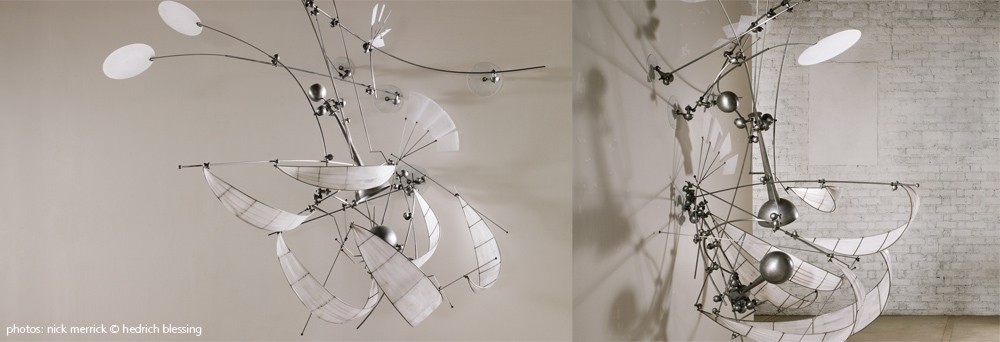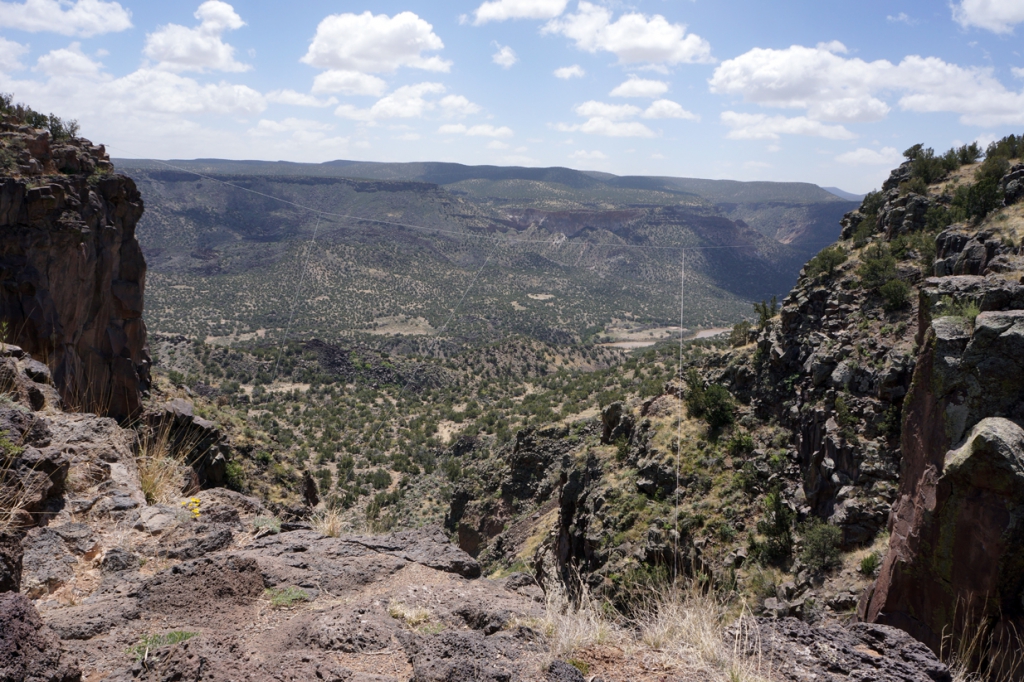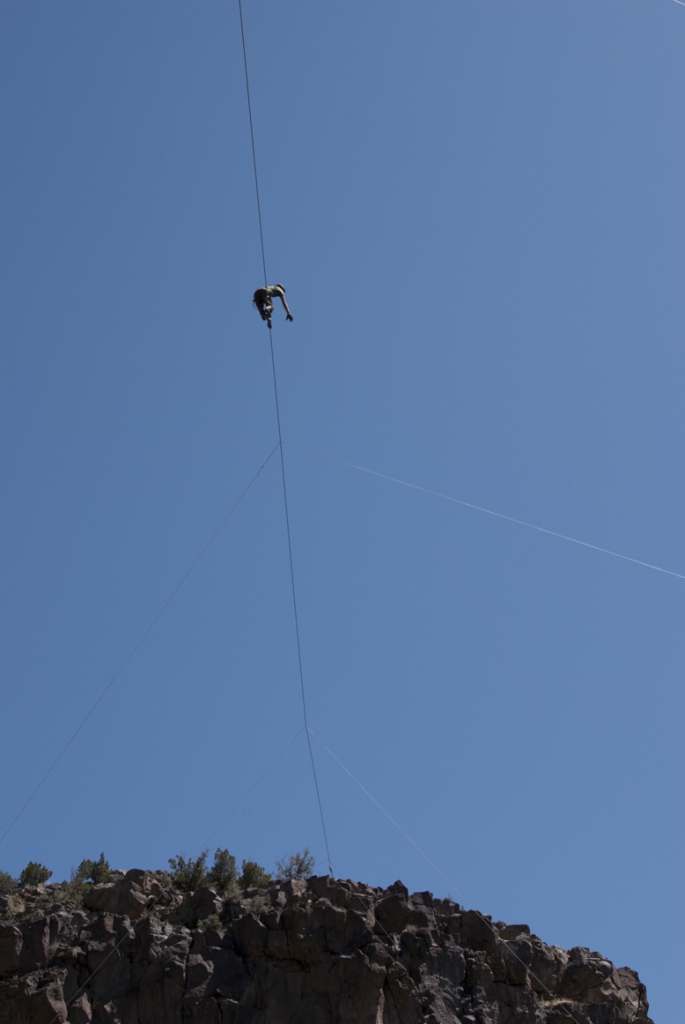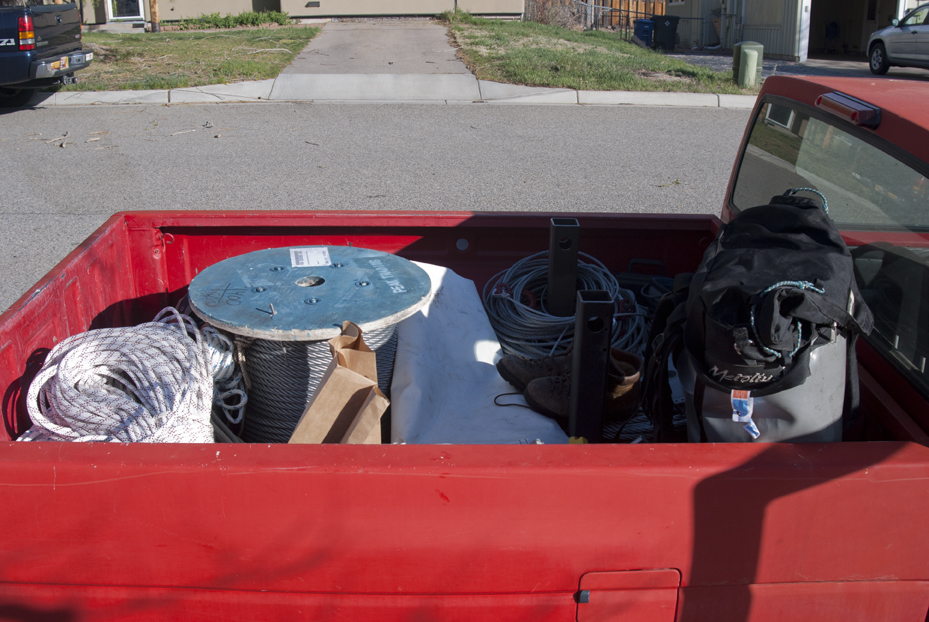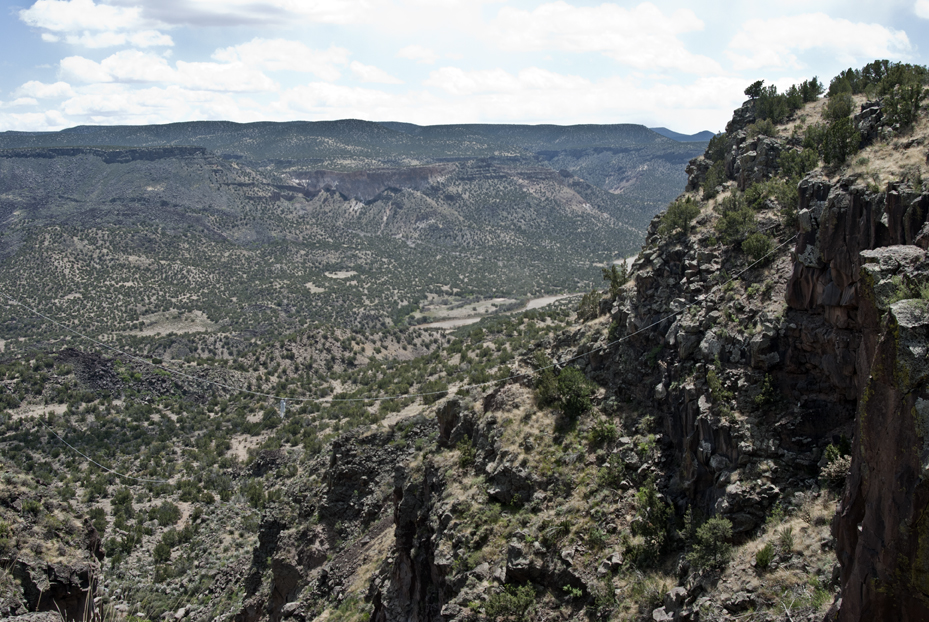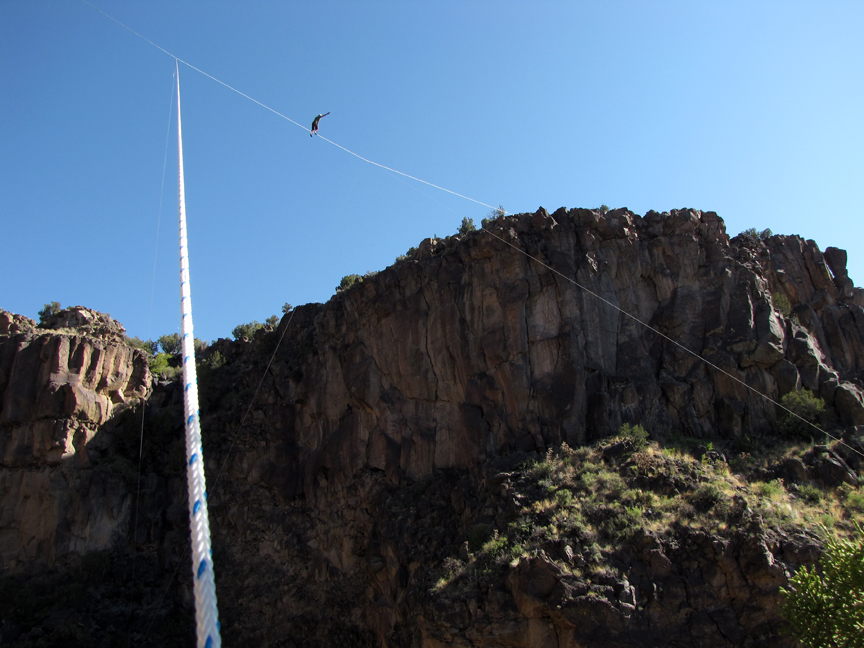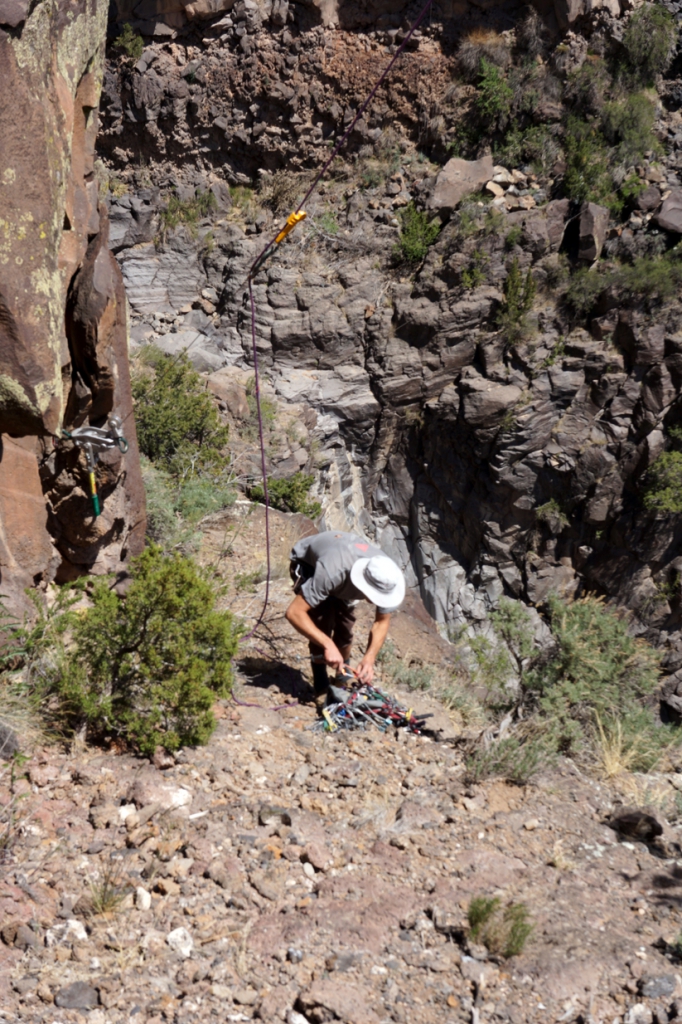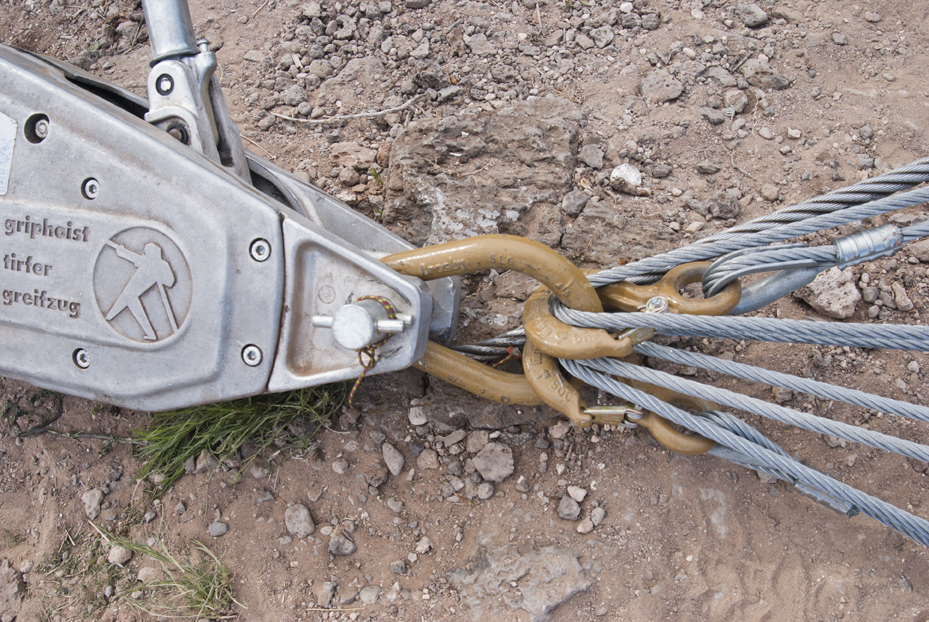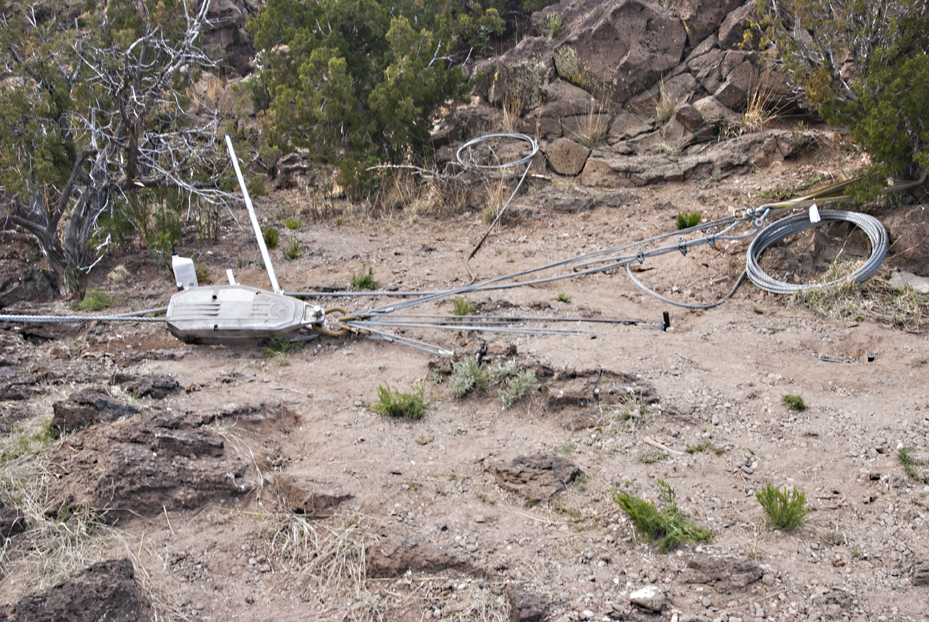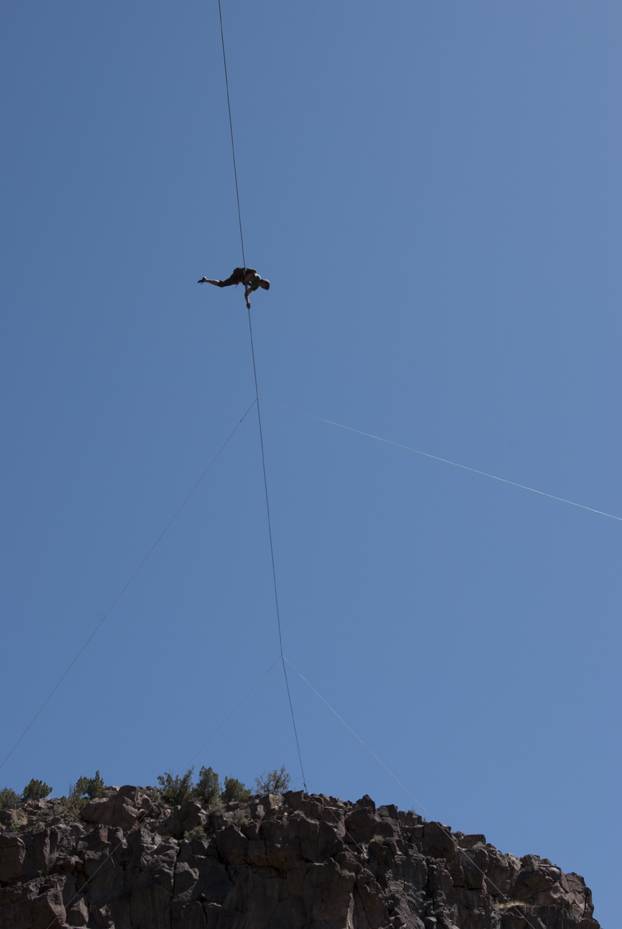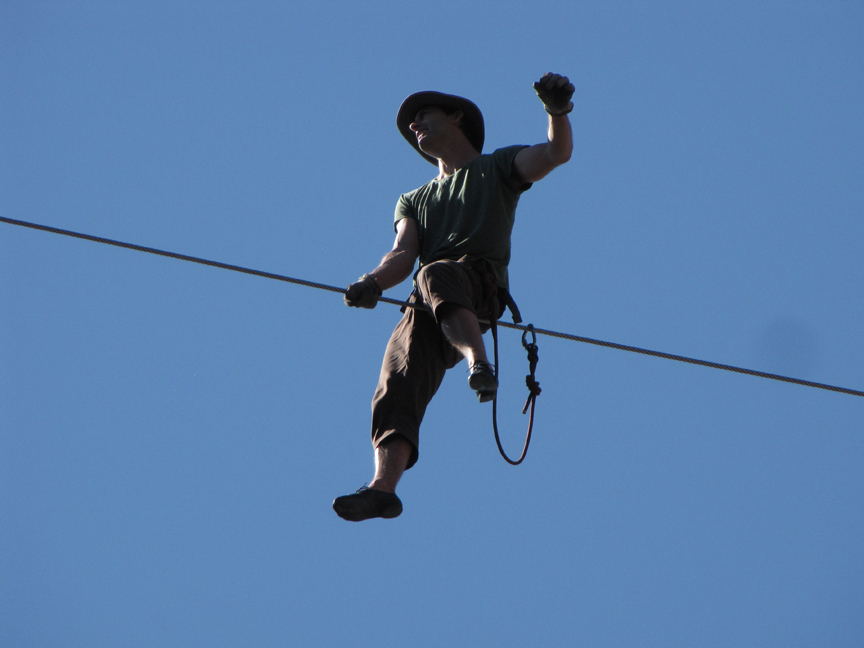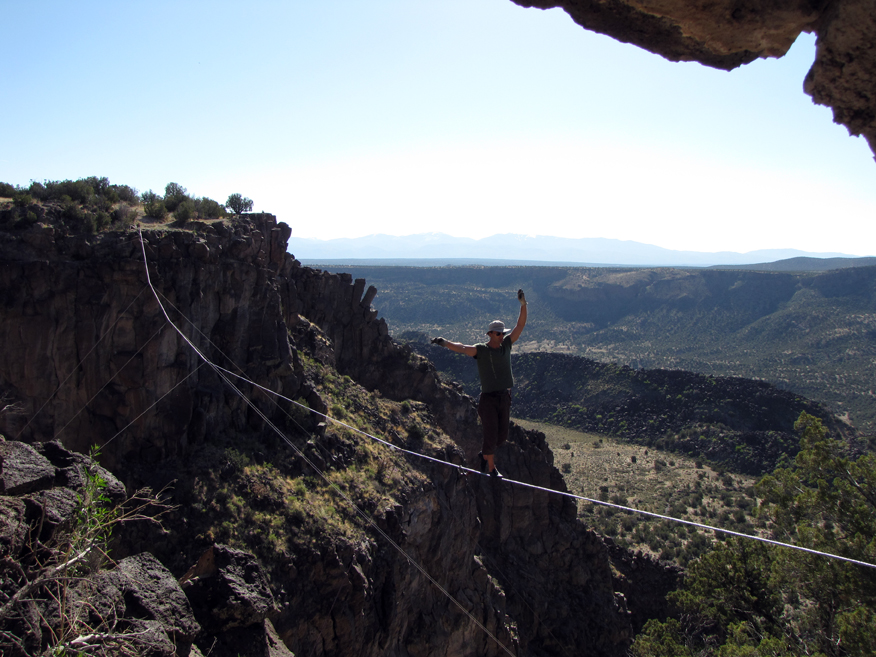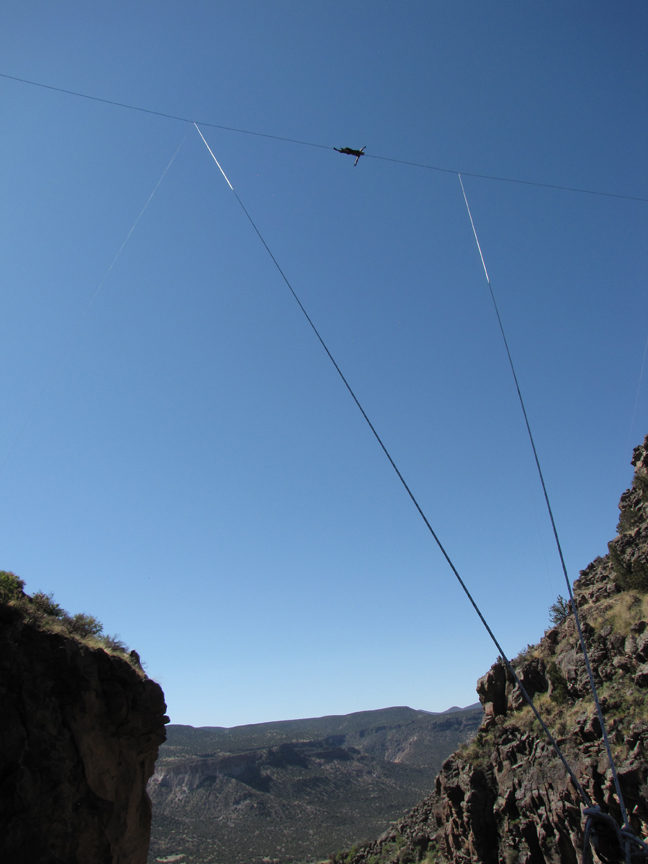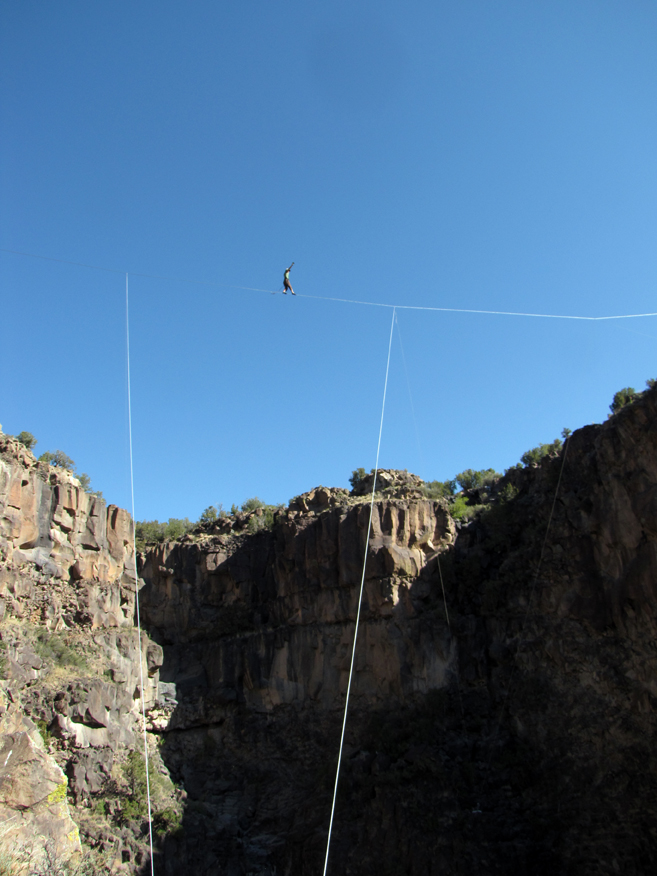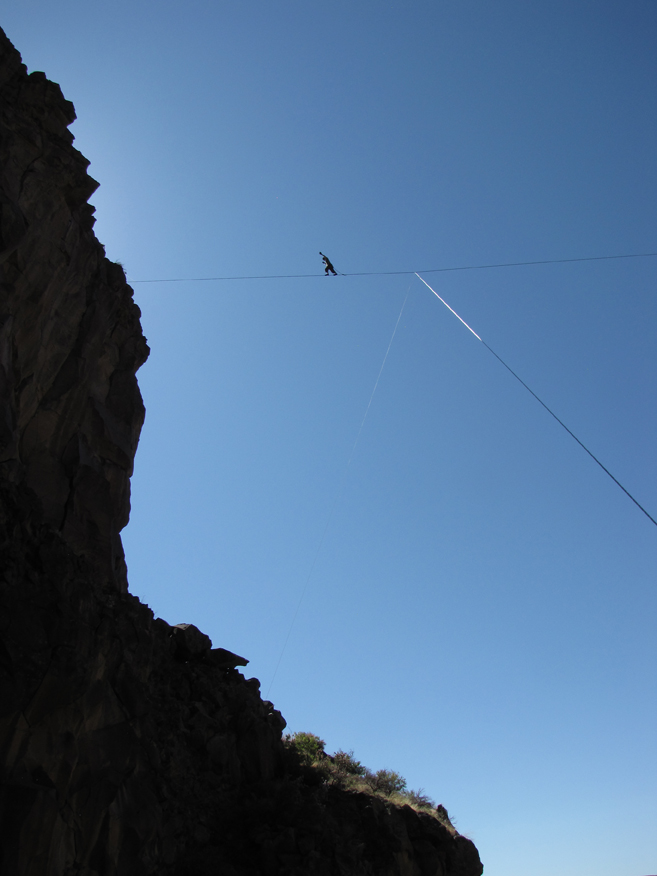Sky Walk Across Pajarito Gorge
For my final process documentation I am submitting a written description and documentation of a sky walk I made across Pajarito Gorge. What follows is a description of the experience, its rigging and the experience of learning to walk on such a wire. I have included pictures and a video of a complete crossing of the wire. Rather than looking back at the work I have done for the past two years I wish to use this moment to focus on my most recent project one which required all of the knowledge and lessons which I have learned over this time.
In the middle of vertiginous space as I walk across the gorge, I react to stay in balance on the wire, but with each reaction I kick oscillations into it. These waves travel out along the wire from my feet, darting along it and reflecting off the anchors. As the waves return, they threaten to rip the wire out from under me. The Cavaletti, the tight Dura Plex lines which stabilize the wire, absorb much of the swing, but in doing so, they begin to dance themselves. The whole apparatus, 400 hundred pounds of wire and Dura Plex, moves chaotically. I feel hopelessly lost in space, a prisoner of my own clumsiness. Like a dingy at sea, just to remain afloat becomes a battle. I collapse downward by landing on the wire in a crash sitting. The wire’s tremors dissipate into my flesh. The wire becomes responsive to my smallest gesture. Underneath even these subtle pulses are others. The wire hums with vibrations which are built by the wind. I realize that the wire’s violent movements are merely a reflection of my chaotic thoughts and reactions.
On the the 28th of April with the help of my friend Chuck Calef I began installing my most ambitious high wire project to date. The wire crossed Pajarito Gorge, which is located on the outskirts of White Rock, a small community of about 6000, a satellite of Los Alamos NM, a town made famous in the 40’s and 50’s for being America’s premier nuclear laboratory. The first atomic bombs were invented and made in Los Alamos. The town is mostly populated by scientists working at the labs and even though it looks like an average American suburb with economy cars and middle class houses, it is, in fact, one of the riches counties in the US. For many years it has ranked within the top five counties in the US for the highest average income.
Chuck met me with his pick up truck in Santa Fe to pick up equipment the day before we began rigging. The most cumbersome piece of equipment was the 400 lb spool of wire rope which had to be transported to the cliff edge and then pulled across the gorge. This spool was rolled bit by bit over rock and through soft sand from the road to the edge of the gorge. This tedious task became ironically comic as it was reversed one week later, and had to be rolled back up the hill.
The first task we undertook was to drive in the anchor stakes which would become the wire rope anchorage on the east side of the gorge. Once the stakes were placed I arranged a cable bridle whose purpose was to transfer an equal load from a master point, a large alloy Crosby Pear Link, to the three stakes which had been driven into cracks in the rocks which rim the gorge. Once this was accomplished, we tried to throw a mason’s line with the aid of a rock partially across the gorge to a shelf which could be reached from the other side. On the first throw I managed to make the toss to the shelf, but unfortunately in an act of utter stupidity we neglected to anchor the other end of the line. After I saw the rock land in the proper place, the line’s end leapt with great speed into the gorge like an ill fated rocket and disappeared into the bottom. It was a comical moment as it was almost surreal in its timing. Right at the beginning we had already experienced a ridiculous failure. After procuring more string, we attempted the toss several more times, but by then the wind had picked up and I never managed to get the rock to land on the shelf like it had on the first toss. We ended up taking a 500’ rope across the gorge, not by pulling it with the thrown line as we had initially intended, but by walking it in stages around the gorge. Now it was time to begin hauling the wire across. The wire was too heavy for hand hauling so a mechanical system to haul and let out the wire had to be employed. On one side of the canyon I hauled with a 3:1 pulley system made from the nylon rope which was tied to the end of the wire rope. On the other side Chuck and Thomas, another friend who had joined us to help stringing the wire, slowly lowered out the heavy wire in increments.
At intervals along the wire Chuck and Thomas attached the Cavaletti, long lengths of Dura Plex rope, which would be tightened to anchors far below in the gorge. The Dura Plex was secured to the wire by a simple clove hitch. Then these ropes were coiled and the coils suspended by the Cavaletti points to keep the ropes from becoming hopelessly tangled in the wind. On the other end I worked hauling the wire at a slowly decreasing rate as the force required to pull the wire’s weight increased as more was let out. When the strenuous work of hauling ceased, the other Crosby Pear Link attached to the wire rope’s end had arrived at the west anchor. I connected it via another self equalizing bridle to the three glue-in bolts which I had placed previously. Returning to the other side, Chuck, Thomas, and I began to arrange a hoist and a wire grip so we could tension the wire to a proofing load of 4.5 tons. Once this proofing load had been achieved and had been held for several minutes without diminishing, we let out on the Tirfor and reduced the load by several tons. Then the next stage of rigging began. I went out on the wire, traversing it with a pulley, to position the Cavaletti and lower out the rope ends. As I hung suspended from the wire, I uncoiled one rope at a time, placed weights on their ends and lowered them down into the gorge. When the ends reached a certain height, I began to swing the weight in great and slow pendulums. At the apex of their swings, they reached Chuck who extended a hand and grabbed hold. He then loosely tied them to the anchors we had placed for the Cavaletti. Then working together we went down into the gorge and scrambled to the location of each line and tightened it.
Once all of the Cavaletti had been attached and tightened at their anchor, we were exhausted from the day’s work and the fierce wind which had battered us all day. As I released the tension from the wire, transferring the load to the longest stake, a large block in front of this stake disrupted, rolling forward and released the stake from the ground. The load shifted back onto what remained of the anchor. Witnessing this created a feeling of horror inside. Although no one was hurt and the failure of this stake had not been catastrophic to the anchor’s ability to take the load, it still awakened serious doubts in my judgement. Up until this point I had trusted the stakes. They had required many blows with a sledge hammer to place in the cracks and the rocks into which they were driven seemed very solid. Now I wondered if the two remaining stakes were susceptible to failing as well. The rock around where they were placed was obscured with soil, so its geometry and structure was not easily determined. When we had applied the test load, the longest stake had most likely been near its limit. Were the other stakes anywhere near failure too? In climbing and rigging there is something called a design factor. A design factor is how strong a piece of equipment or anchor is ultimately, verses how much load it will be subjected to in normal use. For applications where a life is being supported, a minimum design factor of 10:1 is usually used. In 10:1 an anchor which holds 5000lbs before breaking cannot be subjected to more than 500lbs. Short of embarking on serious construction and engineering, it is hard for me to determine the safety margin of the stake anchor, but clearly the long stake which pulled out was much weaker than it should have been. The good news was that the anchor behaved exactly as it was designed. As soon as the stake moved, the load dropped and the friction in the cable bridle kept the pulled stake from flying through the air as the bridle slipped to re-equalize the load onto the remaining two stakes. We left for the day thinking that we needed to seriously rethink the east anchor.
That evening I fell into a deep sleep, only to be startled and awakened by a semi panic, uneasy with the project and uncertain if I should continue or stop. After several hours of cyclical and useless thoughts, sleep returned. In the morning Chuck and I discussed options and came up with a plan. We would find a new placement for the failed stake and again take the whole system up to a proof load. The logic was that the other two stakes were good and if we could find another good placement the anchor would be sufficiently strong. Even if parts of it failed, the anchor would not fail completely. Chuck began probing around in the dirt that overlays the cap rocks. Magically he managed to hit a crack by sheer guessing!! The chances of this seemed mathematically tiny, but it happened. I took this as a good omen. I pounded the stake in with a sledge hammer driving it to near the eye before it would go no more. It seemed extremely solid and put to rest my anchor worries. Next, we descended into the gorge to tension the Cavaletti, the guy ropes which help stabilize the wire. After several hours of climbing around in the rugged terrain of the gorge, the wire was ready for my first attempts.
I put on my wire walking shoes and the belt which attaches my safety tether. I pulled on the leather gloves I wear to protect my hands from the wire. I stepped out onto the wire and immediately lost my balance and grabbed it to arrest my fall. The wire danced about moving several feet from side to side in wild vibrations. After about twenty minutes of attempts with little progress, I realized how difficult this was going to be. With all of the exposure my reactions were gross and I kicked oscillations into the wire which drove the wire and Cavaletti in seizures of movement. Suddenly the wire I was attempting to balance on was moving violently and spastically from side to side. There was nothing solid for me to spot and the best I could do was stand up and waver around for a few moments until the wire danced so violently it forced me to sit back down. Balancing on this wire was completely impossible. Two things became very clear, if I was to succeed in walking this wire, it would have to become more stable and I would have to have near perfect balance not to make it dance about violently. Chuck thought we could get the wire more stable by tightening the Cavaletti, but he doubted this would make much difference in my attempts. I left for the day thinking this is why I never see a high wire walker embarking on a great crossing without a pole. Balancing freehand means that there is more movement. On a long wire oscillations are built in these movements which create a chaotic feedback loop. The funambulist must make greater movements to correct for the dynamic movements of the wire itself which is then driven into an even wilder state making balance impossible. Discouraged, I wondered if walking this wire might be beyond my ability.
Ironically at the same time I felt the excitement born from the discovery of a limit and the possibility of growing beyond it. In my work in the Transart program this was the most profound example of where I felt completely in over my head. I had failed to achieve even balance let alone locomotion on this wire. The wire felt like a wild beast which was driven mad by my presence, shaking me from its back like an unbroken horse. The act of walking the wire in good form with no falls or unnecessary sits seemed so distant.
I arrived earlier the next morning and tightened the Cavaletti once more. I added two more Cavaletti near the ends of the wire, reducing the spans between Cavaletti from one hundred feet to about seventy or eighty feet. I again tried to walk the wire. I found only minimal improvement. I was still thrashing about causing the wire to dance violently. My feet felt as if they would be ripped from the wire as it moved from side to side. As I took a step the shaking of the wire made it hard for the free foot to find the wire again allowing me to take the next step. But by the end of the day I had discovered something! The solution lay inside of me. Up until this point I was trying to solve the shaking wire with an engineering solution. I had thought of using sacks filled with beans or sand draped over the wire close to the anchors to absorb the vibrations and pulses which were throwing me about. Yet I now fully realized the function of the balancing pole as a means to stabilize the funambulist. The pole gives him or her great rotational inertia, allowing for slower more gentle reactions of correction, keeping the wire and the walker calmer.
Yet in my own practice I have stayed away from the pole. I like the purity of using only my body to achieve balance rather than doing it with the aid of props, and because of this I have not learned to use a pole other than messing around with a short piece of steel rod for a couple of days. Perhaps I should be more open to a balancing pole, given it could add confidence so I could execute an elegant and graceful crossing for an audience.
However, the solution to walking on this wire was obvious and simple. In balancing, I must find a way of moving which does not drive the wire into a chaotic state of oscillation.
The solution, one where my balance on the wire was gentle in keeping it quiet, required that I find a point of balance not directly above the wire at any moment in time, but over the center of the wire’s oscillation from side to side. What I believe now made my first attempts unsuccessful was that as the wire swayed about my body instinctively tried to follow it, trying to stay directly over it. This made balance impossible. As I tried to follow the wire, I drove it into a state of violent oscillation, and eventually I could not keep up. To be able to walk the wire I had to let my legs and feet sway with the pulses and dances of the wire and stay over the center point of this dance. This would be fairly easy to do close to the ground where I can use the visual references of the ground to balance, but three hundred feet above ground and far from the ends optical spotting became problematic. Standing on a moving wire a great distance from the solid and stationary world confused my sense of orientation, especially in regards to the subtle balance I needed to execute to keep the wire calm. My technique of optical spotting worked very well on smaller high wires where the ends of the wire were never too distant and I could detect a parallax shift in my sight as my body wavered back and forth above the minute point of balance. But on this wire while facing the absence of matter in every direction for great distances, optical spotting broke down, confusing my balance and causing me to make clumsy movements for which, a moment later, I would be punished as the wire violently bucked about.
I am not sure how to explain exactly what happened, but I started to begin to find balance swinging around in space. At first it happened closer to the ends where the wire was more stable and solid stationary objects were not so distant. I found that if I could focus my mind to rest on the wire and in the slight sensations of movement, I could begin to track the wire’s motions and from there I could attempt to ride it. Slowly I learned to find the point above the swaying wire not by looking for it with my gaze but by feeling for it with my flesh. Gingerly swaying from side to side, I tried to make the most gentle corrections possible to correct imbalances. At first I would feel this balance only for short moments and then I would lose it and drive the wire wild again with a big swing of arms and body. But slowly I learned to hold this attention and sensation of swaying with the wire for longer and longer. After four days of work I crossed the wire without falling and after a rest I crossed it in perfect form without having to sit down to allow the wire to still, (other than having to sit down to unclip and re-clip my safety tether as I passed the Cavalettis.) When I first stepped onto this wire I never imagined what I could accomplish only a few days later. Finding my balance on this wire was something of an ecstasy for me. Like magical discoveries, it revealed itself little by little out of open minded practice in the face of confusion and failure.
After my magical practice on May 5th, I decided that I was ready to announce the small performance which I had planned but had been placed into question by the difficulty I encountered. I planned on sending out an email to invite friends as spectators for a crossing or two. I went home to send out the invitation and directions, but then I received an email from a fellow climber saying that the Los Alamos Police Department had become aware of the wire and needed it to be removed before they destroyed it. After a couple of phone calls and leaving a message, Officer Ross called me back and explained the situation. He said that the wire posed a potential public safety risk and due to the high rate of suicides at the gorge they wanted it removed as soon as possible. I told him that I would take it down the next day. I thought about doing the performance early in the morning and then taking it down, but this seemed like a bad idea, especially after telling him I would remove the wire.
I still had no moving image documentation of my triumphant crossing — only footage of the first days of thrashing about in confusion. I got up very early the next morning and went up to cross the wire for the last times and record these crossings in their entirety as a proof of what I had achieved, if only as project documentation. I set my GoPro camera on a rock with the full length of the wire framed in the view. I then proceeded to walk across the wire as the camera recorded me as a tiny figure, ant like, journeying across a vast landscape. I am sad that I have such poor documentation of what, for me, was a great achievement. On the other hand, it pushes me to continue my work at these endeavors and I hope that some day I will find a way of sharing the experience with more people. By about 9 am the wind had picked up to the point where balancing had become frightening and my friends Chuck and Darien arrived so we began to deinstall the wire. Sadly the wire disappeared just as I was beginning to understand it, but that is the nature of such work. Each moment you have on a clandestinely set up high wire is precious since at any moment the authorities might end it.
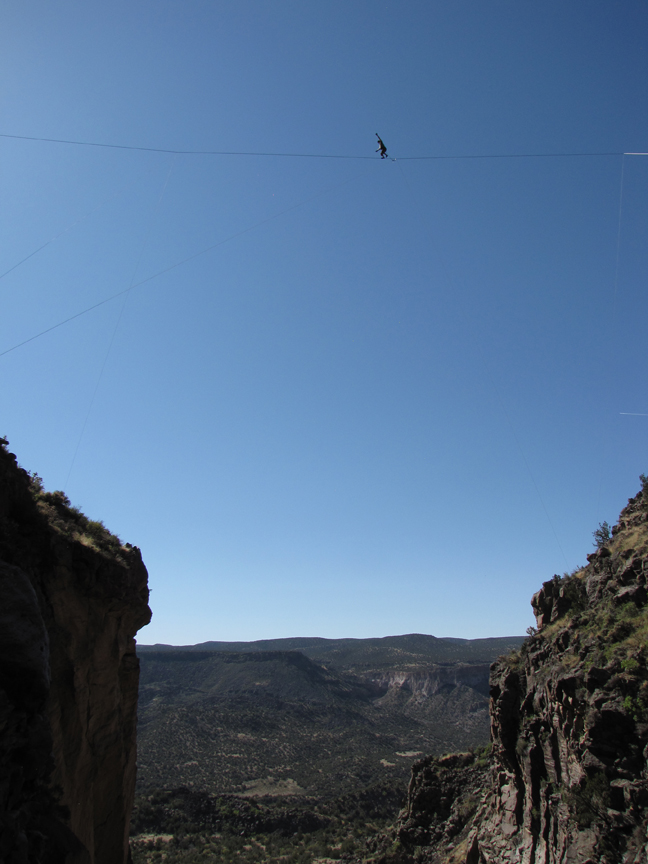
crossing the wire movie, click to watch, I start the crossing on the far right and am difficult to spot in the beginning
The deinstallation went smoothly. During the process officer Chris Ross from the Los Alamos Police Department, whom I had previously spoken to on the phone, but had not yet met in person came to see things and to meet me. I was a little nervous that he might ticket me or arrest me for installing the wire, but on the contrary, he was very relaxed and offered to help. He had watched some YouTube videos of my wire walking and seemed fascinated by the whole endeavor. Rather than the usual cop questions — full name, date of birth and the likes— he asked about rigging the wire and what it was like to be out on it in space. He said that if I wanted to set it up again I could work with the county and they most likely would allow an installation and public performance. He seemed to think it would be a good event for the community. The interaction with Ross reminded me that some police can be curious people who are genuinely interested in providing for the well being of a community. After six hours of work we had everything down and loaded into Chuck’s truck or my car. The project had become a success and most importantly no one was injured.
I have now had a couple of days to reflect on the experience and I think what makes it so important to me was that something which felt completely impossible became possible. How did this shift occur? It seems like such a profound shift. One person I talked to about the process told me “you just became a much better wire walker,” but I don’t think that is the truth. Yesterday I practiced on my little wire and I do not feel that much more stable. No huge improvement in skill occurred, but something profound did happened on the gorge wire. I adapted to the wire, taking my skills and transforming them to work for this different challenge. What is perhaps more interesting is not what happened, but what allowed it to happen. The people who witnessed my first couple of attempts were convinced that crossing without a fall was impossible. Another friend, who witnessed my first day of practice, said that just standing on it looked completely impossible. Chuck said that he thought I could get better, but doubted that I would be able to walk the entire wire. Half believing them I let go of expectations. Then I threw my being into it. After a couple of brutal hours of flailing on the wire one of my friends said, “you might want call it a day, you must be exhausted.” As cliché as it sounds, what allows someone to master something is that they do not give up, but keep perfecting their art long after everyone else has gone home to rest. I convinced myself that this was a time when I was going to need to ignore common sense and push beyond what I was accustomed to doing. Against advice I went out on the wire again trying to find a glimpse of something. It was from this place of defiance, pushing against fatigue, that I felt my first glimpse of how to balance on the wire. For the first time I was able to hold my balance for more than a couple of steps. It was from this point on that I believed I would do it. I believed beyond anything that what I was attempting was not only possible, but possible for me. I did not know how much practice it would take, but I had felt glimpses of being in balance on the wire. This meant it was merely a matter of maintaining this precise balance and attention for an entire crossing instead of losing it after several steps.
People speak of unifying mind and body, but to me it is split in more than in two. It is split in thirds. First there is the me, the inside, the me that thinks and sees and feels and speaks of what should be done. Second there is the me, which is my flesh, my bone and my eyes, all in motion feeling the inertia of energy, decisions, and environment. This part is born and then dies. It is the arrangement and coming together of parts, chemicals and enzymes, nutrients and energy, and then their eventual scattering. The third branch of the split, the non me, are the plants, creatures, minerals, stars and planets of this extraordinary universe which we inhabit.
For several minutes I juggled these three clubs in the air uncertainly keeping from dropping them. The wire, my mind, and my body danced together. The waves and pulses that my reactions created did not send me reaching for the security of a fall or seat, but sent me voyaging on, continuing this juggling act. In someways failure is more comfortable than the effort and concentration faced in intense uncertainty. Sitting on the wire you do not disturb it and you can stay put comfortably, but as soon as you stand up to move forward, you face not just uncertainty, but you present yourself with the reflections and inertia of your actions. Without participating in this struggle, you will never achieve a dream.
I want to acknowledge several individuals who, without their support, this endeavor and the work it births could not exist. First I feel the deepest gratitude to my parents, Bruce Hamilton and Susanna Carlisle, for their ceaseless support and encouragement. They taught me to follow my own dreams, even if they are impractical and uncertain. Without the exposure to their wisdom, depth, and love, I might never have found such joy in life. I would like to thank Charles Calef for his countless hours of work helping me rig and engineer this wire. Without his intelligence and confidence, I would not have be able to embark on such a venture. Thanks to Darien Raistrick for her ceaseless energy and boundlessly positive attitude. I would also like to thank my Transart advisors, Mary Ting and Laura Gonzalez, for the generosity and insight of their ideas which have helped encourage me to follow my heart and dreams rather than succumb to dogma. Lastly I would like to thank my wonderful Transart colleagues whose company, words and ideas have been the wonderful companions of the past two years. And last of all, thanks to the extraordinary and magical thing called awareness. I am blessed to be here now.
Jamie Hamilton
May 15th 2014
